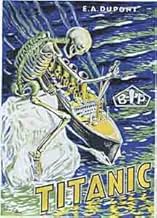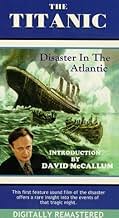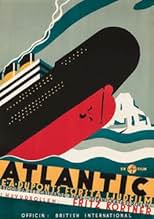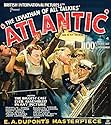On its maiden voyage in April 1912, the supposedly unsinkable RMS Titanic hits an iceberg in the Atlantic Ocean.On its maiden voyage in April 1912, the supposedly unsinkable RMS Titanic hits an iceberg in the Atlantic Ocean.On its maiden voyage in April 1912, the supposedly unsinkable RMS Titanic hits an iceberg in the Atlantic Ocean.
- Director
- Writers
- Stars
Gordon James
- Capt. Collins
- (as Sydney Lynn)
- Director
- Writers
- All cast & crew
- Production, box office & more at IMDbPro
Featured reviews
No movie with Madeleine Carroll in its cast could possibly be unwatchable. That said, I have to add that this British film comes close. The story takes place on board the `SS Atlantic' and it's loosely based on the `Titanic's' unfinished voyage. The word `unsinkable' is spoken, the liner strikes an iceberg, and we hear a heavenly choir sing `Nearer My God to Thee.' The doomed passengers eventually take over the anthem, in a clever bit of sound work. But the year of the film's release (1929) means that a modern viewer has to accept otherwise primitive sound and many of the acting conventions of silent films and the stage. These aren't problems. The film's major flaw is pacing, and pacing had been well developed in silents. However, if the dialog were delivered at a realistic speed, the movie's running time would be cut in half. The intended effect was drama (and clarity in a new medium), but the result unhappily is tiresome now. The film's structure is preposterously illogical and inept. Paradoxically, I found certain details of the editing quite modern in technique: fine, abrupt cuts from one area of the ship to another, sometimes even on sound effects. Although we're on board the `Atlantic' from the first shot, we were well over 4 minutes into the movie before I discovered that fact. There are long, intrusive musical passages by the ship's dance orchestra. (Entertaining, easy sound.) Personal stories are presented in an utterly uninvolving and unconvincing way. Don't even think of spectacle. The berg is a tiny thing and the exterior damage it does to the ship's hull is a minor dent. However, the scenes of passengers swarming into the lifeboats - clearly staged on a real liner, presumably tied up to a dock - generate great excitement. Other than the glorious Miss Carroll, these sequences are the film's only points of excellence. As the movie and the ship near their end, the screen goes totally black several times when the power generators begin to fail. Their last, eternal blackout is the end of the film, with a sunset/sunrise tacked on, a clumsy symbolic effect. `Atlantic' is a cinema curiosity. At best.
From what I understand this was the first movie about the RMS Titanic that featured sound and it was produced in English, German and French (along with a silent version as well). The title was changed to "Atlantic" for fear of lawsuits. In any case, this film essentially depicts a small handful of passengers who have some interpersonal drama going on both before and after the ship hits the iceberg and begins to sink. Initially, most of the passengers are unaware that the ship is sinking which compounds the problem even more. At least that is the scenario that is portrayed in this particular film. Whether any of that is true or not is unknown to me. Be that as it may, I believe that in order for a person to enjoy this movie it is necessary to appreciate the era in which this film was made and for the viewer to make certain allowances for that fact. Likewise, although there have certainly been better films produced pertaining to the subject at hand, this is still a decent movie overall and I have rated it accordingly. Slightly above average.
I purchased this film on DVD to add to my collection of Madeleine Carroll films, and although the stunningly beautiful actress does not have a tremendous amount of screen time, I was not disappointed in the final product. I've never particularly cared for disaster films, and the Cameron blockbuster of a few years ago left me decidedly cold, as it were. Not being an expert on the events surrounding the sinking, I was still quite sure that this mega-hit had little relation to what actually transpired on that fateful night. In any event, I am convinced that the film under review is of greater historical accuracy, and unlike the other reviewers, I am not particularly discouraged to discover that a film made almost 80 years ago is not quite as "spiffy" as more recent products. At the very least, films of this type should be regarded as valuable documents of the ways things were done in the not too distant past, and when you realize that "Atlantic" was made a mere 17 years after the Titanic went down, that is all the more reason to cherish it as an invaluable time capsule of a significant event in the annals of the 20th century that still apparently fascinates a great many people.
As far as the individual performances are concerned, I thought that the players effectively conveyed the starkness of the dilemma the doomed passengers were facing, especially the futility of those remaining men who had hope no hope of salvation, the end being only a matter time. Of particular note was the abrupt contrast between the gay frivolity that permeated the mood immediately before the bad news was conveyed by Lanchester and what immediately followed. Add to that Monica's frantic separation from her husband, as she was literally dragged on to the hanging lifeboat, was quite poignant, made all the more so when the news that she was pregnant became known later.
For those interested in a well made vintage film that provides a fascinating look at a sensational event with which practically everyone alive has at least some inkling of, I highly recommend this film. (And there's the added bonus of a very young Madeleine Carroll to feast your eyes on).
As far as the individual performances are concerned, I thought that the players effectively conveyed the starkness of the dilemma the doomed passengers were facing, especially the futility of those remaining men who had hope no hope of salvation, the end being only a matter time. Of particular note was the abrupt contrast between the gay frivolity that permeated the mood immediately before the bad news was conveyed by Lanchester and what immediately followed. Add to that Monica's frantic separation from her husband, as she was literally dragged on to the hanging lifeboat, was quite poignant, made all the more so when the news that she was pregnant became known later.
For those interested in a well made vintage film that provides a fascinating look at a sensational event with which practically everyone alive has at least some inkling of, I highly recommend this film. (And there's the added bonus of a very young Madeleine Carroll to feast your eyes on).
let me firstly say that too many of these reviewers ,particularly the film student,are viewing the film in a modern context and not as a film made at the coming of sound.In an interview given by John Longden for the BBCs programme "Yesterdays witness" he stated that the ridiculously long pauses between dialogue were entirely the idea of the director.So it is unfair to blame the actors for this.Also in that same programme sound men were interviewed.They said that the effects were recorded on a liner berthed at Tilbury.The ship was linked by phone line to Elstree studios.Before each effect someone would come on the line to describe the effect and it would be recorded at Elstree.The problems with early sound films were quite apparent here.few directors here or in America had the skill of Hitchcock in adapting to the new medium.In fact one should praise the attempt to tell the story in what was then effectively a new medium rather than decry the effort some 84 years later because it is old fashioned.no doubt in the year 2097 young film students will be looking at the like of Man of Steel and chuckling at its antique quaintness.
I was very surprised that I found this 1929 film on YouTube today.. I had no idea it existed and I was excited to see a talking picture made only a decade and a half after the disaster. However, my excitement turned out to be rather muted, as instead of having a grand scope (as ANY picture about the Titanic should have), it looks amazingly claustrophobic. Despite the ship having about 3300 folks aboard (counting crew and passengers), you mostly see scenes with a small handful of folks in them!! I think this is for two reasons. First, the film was obviously made on the cheap. Second, 1929 was the first year for sound pictures in the UK and like the earlier American films of 1927-28, the sound technology was primitive and they had no idea how to film large rooms full of people. Instead, folks had to stand around hidden microphones and talk...which seems unnatural when you see such movies.
As for the title, apparently the White Star Line had a lot of nerve and wouldn't allow the studio to use the name 'Titanic'. I am no barrister, so I have no idea about British law, but this seems more a ploy by White Star than a legitimate case where a copyright or trademark is involved. The sinking of the Titanic was a historical event and mentioning this and the ship's name seem reasonable...and I am not sure why the studio caved and named the movie 'Atlantic' instead of 'Titanic'...but they did.
One thing that was bad about the movie but isn't the filmmakers' fault is that the print is rather jerky and it jiggles a bit. You probably won't need Dramamine to watch the picture, but it is noticeable and annoying.
Another thing to note is that there apparently were several versions of the movie. In the earliest days of sound, they studios had no idea how to dub films into other languages...so they filmed multiple versions in various languages. Laurel & Hardy did this, the Bela Lugosi version of "Dracula" has another version starring a Mexican count and with "Atlantic", they filmed it in German, English AND as a silent (as most theaters didn't have the technology to play sound films yet). And, after finishing the filming, the film was re-cut and French language scenes were added. I saw the English language version...and have no idea if these other versions even exist today nor where you can find them if they do exist.
The movie is odd in that it just begins on the ship in a small drawing room just before the ill-fated crash. I checked...the print I saw WAS the entire 90 minute picture and the normal introduction apparently just wasn't made. This provided little in the way of suspense and over an hour of the film consists of what happens after the ship collides with an iceberg. And, since it was made with very few extras and cast, the whole thing seems a bit small and anticlimactic. But I do cut the film some slack because of when it was made....expecting the same spectacle as in the Nazi propaganda film "Titanic" (1943) or "A Night to Remember" (1958) or "Titanic" (1997) would be ridiculous. Cramped productions were certainly the norm until about 1930-31....and, in hindsight, it might have worked better had they just waited a year or so to make the movie. Additionally, the film lacks reasonably well developed characters and even for 1929, it was a bit of a disappointment in this regard. So, overall it's a very mixed bag for 1929...and a film that must have impressed back in the day but which became quickly dated as well. Mostly of value to the curious and film historians. I give it a 5 because it is watchable and some of the scenes were well made...but overall, it is disappointing and cramped!
As for the title, apparently the White Star Line had a lot of nerve and wouldn't allow the studio to use the name 'Titanic'. I am no barrister, so I have no idea about British law, but this seems more a ploy by White Star than a legitimate case where a copyright or trademark is involved. The sinking of the Titanic was a historical event and mentioning this and the ship's name seem reasonable...and I am not sure why the studio caved and named the movie 'Atlantic' instead of 'Titanic'...but they did.
One thing that was bad about the movie but isn't the filmmakers' fault is that the print is rather jerky and it jiggles a bit. You probably won't need Dramamine to watch the picture, but it is noticeable and annoying.
Another thing to note is that there apparently were several versions of the movie. In the earliest days of sound, they studios had no idea how to dub films into other languages...so they filmed multiple versions in various languages. Laurel & Hardy did this, the Bela Lugosi version of "Dracula" has another version starring a Mexican count and with "Atlantic", they filmed it in German, English AND as a silent (as most theaters didn't have the technology to play sound films yet). And, after finishing the filming, the film was re-cut and French language scenes were added. I saw the English language version...and have no idea if these other versions even exist today nor where you can find them if they do exist.
The movie is odd in that it just begins on the ship in a small drawing room just before the ill-fated crash. I checked...the print I saw WAS the entire 90 minute picture and the normal introduction apparently just wasn't made. This provided little in the way of suspense and over an hour of the film consists of what happens after the ship collides with an iceberg. And, since it was made with very few extras and cast, the whole thing seems a bit small and anticlimactic. But I do cut the film some slack because of when it was made....expecting the same spectacle as in the Nazi propaganda film "Titanic" (1943) or "A Night to Remember" (1958) or "Titanic" (1997) would be ridiculous. Cramped productions were certainly the norm until about 1930-31....and, in hindsight, it might have worked better had they just waited a year or so to make the movie. Additionally, the film lacks reasonably well developed characters and even for 1929, it was a bit of a disappointment in this regard. So, overall it's a very mixed bag for 1929...and a film that must have impressed back in the day but which became quickly dated as well. Mostly of value to the curious and film historians. I give it a 5 because it is watchable and some of the scenes were well made...but overall, it is disappointing and cramped!
Did you know
- TriviaThe White Star Line forbade the production company from referring to the ship in this film as The Titanic.
- GoofsSet in 1912, he women's hairstyle and dresses are from 1929.
- Alternate versionsReleased with separate English, French and German soundtracks.
- ConnectionsAlternate-language version of Atlantik (1929)
- SoundtracksWalking With Susie
(uncredited)
Written by G.H. Elliott
Played by the ship's band as Larry and Monica enter the Smoking Room.
Details
- Release date
- Country of origin
- Language
- Also known as
- Titanic: Disaster in the Atlantic
- Filming locations
- Production company
- See more company credits at IMDbPro
Box office
- Budget
- £2,000 (estimated)
- Runtime1 hour 30 minutes
- Color
- Aspect ratio
- 1.20 : 1
Contribute to this page
Suggest an edit or add missing content




































